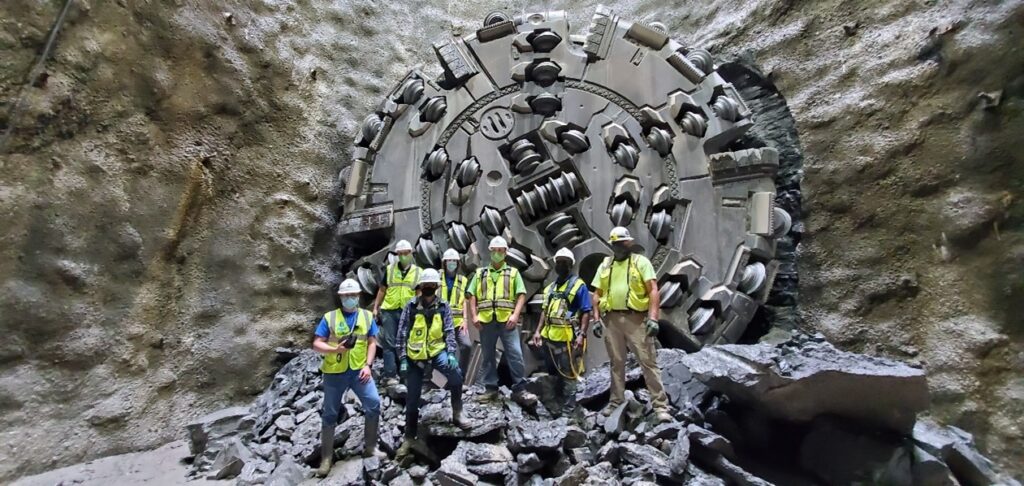By R. M. TRUE
As wet-weather events escalate in frequency and intensity, many cities in the US are facing the challenges of aging civil infrastructure, while also undergoing unprecedented population and business growth. As wet weather persists, in part bolstered by climate change, cities require modern infrastructure solutions for these modern challenges. As conventional solutions prove inadequate, innovative tunneling approaches are emerging as effective strategies to manage Combined Sewer Overflows (CSOs) and other critical infrastructure needs while establishing resilient urban frameworks. A tangible example can be found in Louisville, KY, where the completion of Louisville and Jefferson County Metropolitan Sewer District’s (MSD) Waterway Protection Tunnel (WPT) has redefined CSO management and demonstrated the significance of progressive infrastructure.
Facing stringent regulatory demands and the need to protect vital, local water bodies like the Ohio River, Louisville MSD initially planned the construction of several large near-surface CSO storage basins as part of an Integrated Overflow Abatement Plant (IOAP). However, since the location of a few basins would cause potential disruptions to stakeholders — many of which were igniting the city’s recent “bourbon boom”—an innovative, yet practical alternative was proposed by engineering consultant Black & Veatch. Utilizing their experience from the “Dig Indy” CSO tunneling program just 100-miles north of Louisville in Indianapolis, IN (Citizens Energy Group), Black & Veatch championed the concept of a large diameter, deep bedrock CSO storage and conveyance tunnel.

In Fall 2017, after an expedited 8-month design led by Black & Veatch, construction began on the 2.5-mile, 20-foot diameter ORT, excavated approximately 180-220 feet beneath downtown Louisville, which eliminated three CSO storage basins. Shortly after assembling the tunnel boring machine (TBM), Louisville MSD requested Black & Veatch to design an additional 1.5-miles of tunnel, which eliminated the fourth CSO basin. In total, the extended, 4.0-mile ORT provided an 11 million gallon (MG) CSO storage surplus to that of the 44 MG of the basins, totaling 55 MG. Construction of the ORT was performed by a joint venture between J. F. Shea and Traylor-Brothers (S-T JV), and managed by Black & Veatch, from Fall 2017 to Summer 2022. While the TBM—named “Bumblebee” after local boxing legend Muhammed Ali’s coined quip—bored under Louisville through 500-million-year-old bedrock, community stakeholders 200-feet above thrived.

The tunnel not only eliminated four storage basins and their associated pump stations, but addressed many of their limitations and shortcomings. Namely, the WPT provided a cost-effective CSO management solution with minimal impact to community stakeholders and, following construction, accommodated sustainable green spaces at the launch and terminus shaft sites where two of the eliminated storage basins were originally to be constructed. With the tunnel construction depth, land use and real estate values along the alignment remained unaffected. Moreover, the deep tunnel was able to navigate under elevated highways, the Ohio River itself, a bridge connecting Kentucky and Indiana, commercial establishments, and railway tracks, without any surface interferences.
Just over two years have transpired since the completion of Louisville MSD’s WPT, and its progressive influence is already palpable. To date, the WPT has captured nearly 1.25-billion gallons of CSO for downstream treatment that would have otherwise flowed directly into the Ohio River, among other local waterways.
In a world overflowing with societal change and environmental challenges, Louisville MSD’s and Black & Veatch’s success with the WPT underscores the potential that innovative tunneling infrastructure offers for cities with aggressive CSO management goals or other similar infrastructure needs. Such success is not confined to engineering pragmatism; it mirrors a broader societal shift. A shift where managing water, wastewater and stormwater evolves from a challenge to a triumph, with each tunnel propelling us closer to a reality where growth, change, and the environment coalesce harmoniously. After all, communities thrive in spaces enriched by a balance between urban development and ecological stewardship.
With a 100-yr design life, the WPT, fosters an unprecedented, century-long ethical stewardship of Kentucky’s environment and culture.
About the author
R. M. True is a civil engineer working on critical civil infrastructure in north-central Kentucky. True assisted with the design and construction management of Louisville MSD’s Waterway Protection Tunnel, and continues to work alongside Louisville MSD and other local municipalities and townships to provide engineering expertise and construction oversight. True received his B.S. in Civil Engineering from the University of Kentucky, and later earned an M.A. in English at Texas Tech University. True founded The Kentucky Steward LLC in 2022 and looks forward to promoting and characterizing the ethical stewardship of Kentucky.